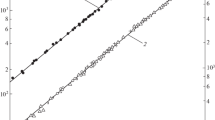Equations are derived for mean friction and heat-transfer coefficients to solve problems of updating industrial plants for getting oil fractions based on application of approximate method for modeling momentum and heat transfer in heat exchangers with surface intensifiers. The Deissler and Van-Driest turbulent boundary-layer model is used for the turbulent viscosity function for a flat smooth wall. An equation is derived for the Stanton number using Chilton-Colburn hydrodynamic analogy, and agreement with the known analogy is shown. Identical local properties of turbulent motion in the boundary layer on a plate and in the wall layer of a tube and the conservative properties of the laws of friction and heat transfer to turbulences, which are taken account of parametrically, are used for modeling momentum and heat transfer in channels with surface intensifiers. Equations are derived for the mean tangential stress in the channels with intensifiers and for the Nusselt number using a dissipative model. The results of calculations and comparison with the known experimental investigations are given for tubes with surface wire inserts, with spiral finning and rectangular projections for transformer oil at Reynolds numbers 200 < Re < 2000. Thus, the adequacy of the developed mathematical model is proved in a wide range of operating and design parameters and thermophysical properties of liquids and gases. Further, the hydraulic resistance of the channel is the key experimental information about the object of modeling. Examples of use of mathematical model for designing and commissioning heat exchangers in petroleum fuels fractionating plants at industrial enterprises in the Russian Federation and abroad are given.


Similar content being viewed by others
References
I. A. Golubeva, D. S. Khudyakov, and E. V. Rodina, Chemistry and Technology of Fuels and Oils, 56, No. 3, 395-404 (2020).
A. G. Laptev, A. D. Gilyazov, and Е. А. Lapteva, Khim. Tekhnol. Topl. Masel, 57, No. 1, 3-6 (2021).
A. I. Leontev and V. V. Olimpiev, Teplofiz. Vysok. Temp., 45, No. 6, 925-953 (2007).
Yu. F. Gortyshev, I. A. Popov, V. V. Olimpiev, et al., Thermohydraulic Efficiency of Prospective Heat Transfer Intensification Methods in Heat Exchanging Equipment Channels [in Russian], Innovative Technologies Center, Kazan, Russia (2009), p. 531.
I. E. Lobanov, Innovts. Podkhody Otrasl. Sfer., 3, No. 7, 20-25 (2018).
E. K. Kalinin, G. A. Dreitser, I. Z. Kopp, et al., Efficient Heat Exchanger Surfaces [in Russian], Energoatomizdat, Moscow (1988), p. 407.
Yu. G. Nazmeev, Heat Exchange in Laminar Fluid Flow in Discretely Rugged Channels [in Russian], Energoatomizdat, Moscow (1998), p. 376.
S. S. Kutateladze and A. I. Leontev, Heat and Mass Transfer and Friction in Boundary Layer [in Russian], Energiya, Moscow (1985), p. 319.
A. G. Laptev and T. M. Farakhov, J. Eng, Phys. Thermophys., 86, No. 3, 604-613 (2013).
A. G. Laptev and M. M. Basharov, J, Eng, Phys. Thermophys., 88, No. 3, 681-687 (2015).
A. G. Laptev, T. M. Farakhov, and M. M. Basharov, Thermal Engineering, 66, No. 8, 580-586 (2019).
L. G. Loitsyanskii, Liquid and Gas Mechanics [in Russian], Drofa, Moscow (2003), p. 840.
J. O. Hintse, Turbulence: An Introduction to Its Mechanism and Theory, McGraw Hills, New York (1959), p. 586 [Russian translation edited by G. N. Abramovich, Fizmatgiz, Moscow (1963), p. 680].
A. D. Girgidov, Mechanics of Liquid and Gas (Hydraulics) [in Russian], Izd. SPbGPU, St. Petersburg (2003), p. 545.
A. D. Girgidov, Inzhenerno-stroitelnyi Zh., No. 6, 5-11 (2012).
A. N. Skrypnik, A. V. Shchelchkov, I. A. Popov, et al., Journal of Engineering Physics and Thermophysics, 91, No. 1, 52-63 (2018).
A. N. Skrypnik, Hydraulic Resistance and Heat Transfer of Tubes with Internal Spiral Finning during Single-phase Heat Carrier Flow [in Russian], Candidate’s dissertation, KNITU=KAI, Kazan (2020).
A. G. Laptev, A. G., Farakhov, and E. A. Lapteva, Journal of Engineering Thermophysics, 30, No. 2, 23-30 (2021).
M. M. Basharov, I. I. Salakhov, L. S. Alekhin, et al., Vestn. Tekhnol. Univ., 19, No. 20, 40-42 (2016).
M. I. Farakhov, A. A. Akhmitshin, A. G. Laptev, et al., in collection: IOP Conference Series: Materials Science and Engineering. 2. Mining, Production, Transmission. Sеr. II International Scientific and Practical Conference “Actual Problems of the Energy Complex: Mining, Production, Transmission, Processing and Environmental Protection,” 2020, page 012017.
Author information
Authors and Affiliations
Corresponding author
Additional information
Translated from Khimiya i Tekhnologiya Topliv i Masel, No. 6, pp. 44–50, November – December, 2021.
Rights and permissions
About this article
Cite this article
Laptev, A.G., Lapteva, E.A. & Akhmitshin, A.A. Modeling of Intensified Heat Exchangers with Different Viscosities of Fluids. Chem Technol Fuels Oils 57, 917–925 (2022). https://doi.org/10.1007/s10553-022-01329-z
Published:
Issue Date:
DOI: https://doi.org/10.1007/s10553-022-01329-z



